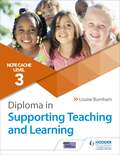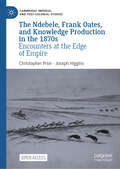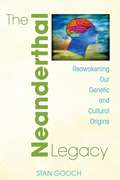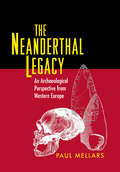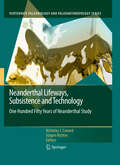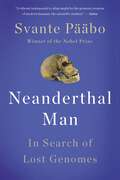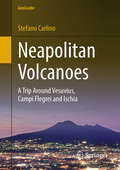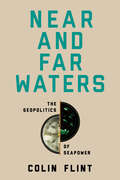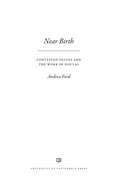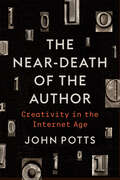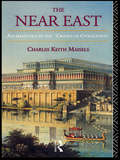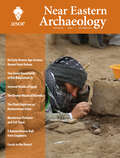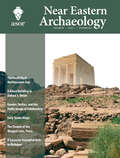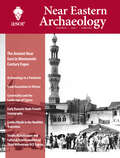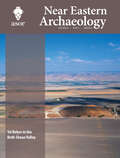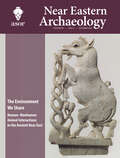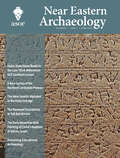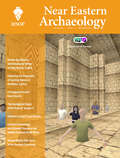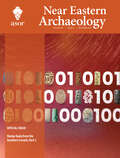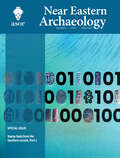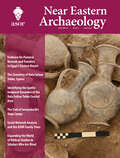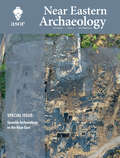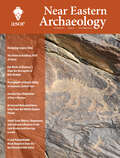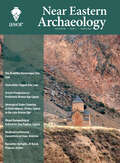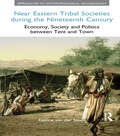- Table View
- List View
NCFE CACHE Level 3 Diploma in Supporting Teaching and Learning: Get expert advice from author Louise Burnham
by Louise BurnhamMake a difference to classroom learning with this textbook, written for the CACHE qualification by highly respected and experienced author Louise Burnham.-Develop your skills as a teaching assistant with coverage of all units in the new CACHE qualification. -Build confidence in your role with practical advice and full explanations from best-selling author Louise Burnham. -Translate theory into practice with Tips for Best Practice and Case Studies for challenging topics such as Behaviour Management.-Strengthen your understanding of theory and practice, with comprehensive information linked clearly to assessment criteria.-Find all the information you need with the colourful, clear design, and appropriate language throughout. -Make the most of your training with the Stretch and Challenge feature.-Engage in debate on important topics with Classroom Discussion suggestions.
The Ndebele, Frank Oates, and Knowledge Production in the 1870s: Encounters at the Edge of Empire (Cambridge Imperial and Post-Colonial Studies)
by Christopher Prior Joseph HigginsThis open access book addresses a question fundamental to the histories of empire and Africa: at the point of the colonial encounter, how was knowledge made? How did different communities, with little or no prior contact, construct meaning about one another? Amidst huge changes in the politics and economics of a continent, on the cusp of almost complete colonization at the hands of European powers at the end of the nineteenth century, how do the specifics of personality and contingency affect knowledge production? An obvious challenge in addressing this sort of question is the frequent lack of African-produced source material; here, we must work within the ‘archives of oppression’ and read both along and against the colonial grain in an attempt to restore African agency to this process of knowledge production. Drawing on the previously never-used diaries of explorer Frank Oates, who travelled throughout Matabeleland in the 1870s, the use of a single traveller’s experiences in detail affords us the means to consider the fine details of the interactions between Europeans and Africans. Therefore, this study seeks to enhance existing work on race and empire of the nineteenth century by asking: what place do the fragilities, uncertainties, and contingencies of encounters between individuals have in our understanding of how knowledge is made?
The Neanderthal Legacy: Reawakening Our Genetic and Cultural Origins
by Stan GoochA direct appeal for a revolution in our educational system to restore the connection with our Neanderthal heritage • Examines the genetic evidence for Neanderthal/Cro-Magnon crossbreeding and the dual-nature effects this hybrid cross produced • Explains the influence of the Neanderthal’s enlarged cerebellum on our modern brain function and psychic and paranormal abilities In The Neanderthal Legacy, eminent psychologist and paranormal researcher Stan Gooch brings together the wide-ranging investigative strands of his lifetime of study of the human brain. One of the world’s leading experts on the influence of Neanderthal Man on the cultural and biological development of humanity, Gooch contends that the Neanderthals’ enlarged cerebellum was a source of deep connection with the psychic and dream worlds, which remains extant in modern man in paranormal phenomena that conventional science cannot explain.Gooch offers new scientific evidence of the crossbreeding between Neanderthals and Cro-Magnons that is responsible for the dichotomous nature of our feelings, thoughts, impressions, beliefs, and even our cultural mores and politics. The “hybrid vigor” produced by this mating has gifted modern man with abilities and sensibilities that the scientific establishment and conventional educational system entirely ignore. The author explores the legacy of our Neanderthal ancestors in an effort to awaken their virtues and qualities, which are so needed in our modern world.
The Neanderthal Legacy
by Paul A. MellarsThe Neanderthals populated western Europe from nearly 250,000 to 30,000 years ago when they disappeared from the archaeological record. In turn, populations of anatomically modern humans, Homo sapiens, came to dominate the area. Seeking to understand the nature of this replacement, which has become a hotly debated issue, Paul Mellars brings together an unprecedented amount of information on the behavior of Neanderthals. His comprehensive overview ranges from the evidence of tool manufacture and related patterns of lithic technology, through the issues of subsistence and settlement patterns, to the more controversial evidence for social organization, cognition, and intelligence. Mellars argues that previous attempts to characterize Neanderthal behavior as either "modern" or "ape-like" are both overstatements. We can better comprehend the replacement of Neanderthals, he maintains, by concentrating on the social and demographic structure of Neanderthal populations and on their specific adaptations to the harsh ecological conditions of the last glaciation. Mellars's approach to these issues is grounded firmly in his archaeological evidence. He illustrates the implications of these findings by drawing from the methods of comparative socioecology, primate studies, and Pleistocene paleoecology. The book provides a detailed review of the climatic and environmental background to Neanderthal occupation in Europe, and of the currently topical issues of the behavioral and biological transition from Neanderthal to fully "modern" populations.
Neanderthal Lifeways, Subsistence and Technology
by Jürgen Richter Nicholas J. ConardThe 150th anniversary of the discovery of the famous Neanderthal fossils gave reason for an international and interdisciplinary symposium in Bonn/Germany. The present book arose from this congress and focuses on multiple aspects of archaeological investigation on Neanderthal lifeways. In-depth studies of top-ranking scientists provide a detailed and comprehensive survey of contemporary research on our Pleistocene relatives. Examinations and debates are embedded in a variety of regions and time frames. Chronology, subsistence, land use, and cultural adaptations among late Neanderthals form the major trajectories of the book. The wide range of approaches involved, leads to an increasing understanding of the facets of and the variability of Neanderthal behavioural patterns. The present volume is complemented by a paleontologically orientated publication of the same congress (edited by Gerd-Christian Weniger and Silvana Condemi).
Neanderthal Man: In Search of Lost Genomes
by Svante PaaboA preeminent geneticist hunts the Neanderthal genome to answer the biggest question of them all: what does it mean to be human? What can we learn from the genes of our closest evolutionary relatives? Neanderthal Man tells the story of geneticist Svante Pääbo’s mission to answer that question, beginning with the study of DNA in Egyptian mummies in the early 1980s and culminating in his sequencing of the Neanderthal genome in 2009. From Pääbo, we learn how Neanderthal genes offer a unique window into the lives of our hominin relatives and may hold the key to unlocking the mystery of why humans survived while Neanderthals went extinct. Drawing on genetic and fossil clues, Pääbo explores what is known about the origin of modern humans and their relationship to the Neanderthals and describes the fierce debate surrounding the nature of the two species’ interactions. A riveting story about a visionary researcher and the nature of scientific inquiry, Neanderthal Man offers rich insight into the fundamental question of who we are.
Neapolitan Volcanoes: A Trip Around Vesuvius, Campi Flegrei and Ischia (GeoGuide)
by Stefano CarlinoThis book serves as a guide to discovering the most interesting volcano sites in Italy. Accompanied by some extraordinary contemporary images of active Neapolitan volcanoes, it explains the main volcanic processes that have been shaping the landscape of the Campania region and influencing human settlements in this area since Greek and Roman times and that have prompted leading international scientists to visit and study this natural volcanology laboratory. While volcanology is the central topic, the book also addresses other aspects related to the area’s volcanism and is divided into three sections: 1) Neapolitan volcanic activity and processes (with a general introduction to volcanology and its development around Naples together with descriptions of the landscape and the main sites worth visiting); 2) Volcanoes and their interactions with local human settlements since the Bronze Age, recent population growth and the transformation of the territory; 3) The risks posed by Neapolitan Volcanoes, their recent activity and the problem of forecasting any future eruption.
Near and Far Waters: The Geopolitics of Seapower
by Colin FlintSeapower has been a constant in world politics, a tool through which powerful countries have policed the seas for commercial advantage. Political geographer Colin Flint highlights the geography of seapower as a dynamic, continual struggle to gain control of near waters—those parts of the oceans close to a country's shoreline—and far waters—parts of the oceans beyond the horizon and that neighbor the shorelines of other countries. A forceful and clarifying challenge to conventional accounts of geopolitics, Near and Far Waters offers an accessible introduction to the combination of economic and political relations that are the reason behind, and the result of, the development of seapower to control near waters and project force into far waters. Examining the histories of three naval powers (the Netherlands, Britain, and the United States), this book distills the past and present patterns of seapower and their tendency to trigger repercussive conflict and war. Readers will gain an appreciation for how geopolitics works, the importance of seapower in economic competition, the motivations behind China's desire to become a global naval force, and the risks of current and future wars. Drawing on decades of experience, Flint urges readers to take seriously the dilemma of near/far waters as a context for an alternative understanding of global politics.
Near Birth: Contested Values and the Work of Doulas
by Dr. Andrea Lilly FordThis insightful study of contemporary birthing uses the work of doulas to explore the questions raised near birth: What do we value, and how do we navigate those values when they are tangled in conflict? Pregnancy, birthing, and infant care offer a microcosm of cultural debates. In this ethnography of childbearing in Northern California, Andrea Ford examines how people's birthing decisions and experiences relate to and construct the American ideal of the individual through the values of progress, experience, autonomy, equality, authenticity, immunity, and redemption. Both an anthropologist and a doula who has observed and participated in dozens of births, Ford explores how parents, practitioners, activists, laws, technologies, media, and medical institutions shape the politics of care. Near Birth shows that questions about the best way to have a baby concern much more than health procedures. In the answers lie often-unacknowledged claims about what kinds of personhood matter and what ways of living are valued and valuable.
The Near-Death of the Author: Creativity in the Internet Age
by John PottsIn the modern world of networked digital media, authors must navigate many challenges. Most pressingly, the illegal downloading and streaming of copyright material on the internet deprives authors of royalties, and in some cases it has discouraged creativity or terminated careers. Exploring technology’s impact on the status and idea of authorship in today’s world, The Near-Death of the Author reveals the many obstacles facing contemporary authors. John Potts details how the online culture of remix and creative reuse operates in a post-authorship mode, with little regard for individual authorship. The book explores how developments in algorithms and artificial intelligence (AI) have yielded novels, newspaper articles, musical works, films, and paintings without the need of human authors or artists. It also examines how these AI achievements have provoked questions regarding the authorship of new works, such as Does the author need to be human? And, more alarmingly, Is there even a need for human authors? Providing suggestions on how contemporary authors can endure in the world of data, the book ultimately concludes that network culture has provoked the near-death, but not the death, of the author.
The Near East: Archaeology in the 'Cradle of Civilization' (Experiences Of Archaeology Ser.)
by Charles Keith MaiselsThe transition from foraging, farming and the neolithic village to the city-state is a complex and fascinating period. Studies on the prehistory of the Near East by nineteenth and twentieth century pioneers in the field transformed archaeology through the creation of the 'Ages System' of Stone, Bronze and Iron. The Near East provides a developmental account of this period contextualised by discussion of the emergence of archaeology as a discipline.The Near East details the causes and effects - enviromental, organizational, demographic and technological - of the world's first village farming cultures some eight thousand years ago. Charles Maisels explains how cities such as Uruk and Ur, Nippur and Kish formed as a result of geological factors and the role of key organizational features of Sumerian society in introducing the world's first script, system of calculation and literature.
Near Eastern Archaeology, volume 84 number 3 (September 2021)
by Near Eastern ArchaeologyThis is volume 84 issue 3 of Near Eastern Archaeology. Archaeological discoveries continually enrich our understanding of the people, culture, history, and literature of the Middle East. The heritage of its peoples—from urban civilization to the Bible—both inspires and fascinates. Near Eastern Archaeology brings to life the ancient world from Mesopotamia to the Mediterranean with vibrant images and authoritative analyses.
Near Eastern Archaeology, volume 84 number 4 (December 2021)
by Near Eastern ArchaeologyThis is volume 84 issue 4 of Near Eastern Archaeology. Archaeological discoveries continually enrich our understanding of the people, culture, history, and literature of the Middle East. The heritage of its peoples—from urban civilization to the Bible—both inspires and fascinates. Near Eastern Archaeology brings to life the ancient world from Mesopotamia to the Mediterranean with vibrant images and authoritative analyses.
Near Eastern Archaeology, volume 85 number 1 (March 2022)
by Near Eastern ArchaeologyThis is volume 85 issue 1 of Near Eastern Archaeology. Archaeological discoveries continually enrich our understanding of the people, culture, history, and literature of the Middle East. The heritage of its peoples—from urban civilization to the Bible—both inspires and fascinates. Near Eastern Archaeology brings to life the ancient world from Mesopotamia to the Mediterranean with vibrant images and authoritative analyses.
Near Eastern Archaeology, volume 85 number 2 (June 2022)
by Near Eastern ArchaeologyThis is volume 85 issue 2 of Near Eastern Archaeology. Archaeological discoveries continually enrich our understanding of the people, culture, history, and literature of the Middle East. The heritage of its peoples—from urban civilization to the Bible—both inspires and fascinates. Near Eastern Archaeology brings to life the ancient world from Mesopotamia to the Mediterranean with vibrant images and authoritative analyses.
Near Eastern Archaeology, volume 85 number 4 (December 2022)
by Near Eastern ArchaeologyThis is volume 85 issue 4 of Near Eastern Archaeology. Archaeological discoveries continually enrich our understanding of the people, culture, history, and literature of the Middle East. The heritage of its peoples—from urban civilization to the Bible—both inspires and fascinates. Near Eastern Archaeology brings to life the ancient world from Mesopotamia to the Mediterranean with vibrant images and authoritative analyses.
Near Eastern Archaeology, volume 86 number 1 (March 2023)
by Near Eastern ArchaeologyThis is volume 86 issue 1 of Near Eastern Archaeology. Archaeological discoveries continually enrich our understanding of the people, culture, history, and literature of the Middle East. The heritage of its peoples—from urban civilization to the Bible—both inspires and fascinates. Near Eastern Archaeology brings to life the ancient world from Mesopotamia to the Mediterranean with vibrant images and authoritative analyses.
Near Eastern Archaeology, volume 86 number 3 (September 2023)
by Near Eastern ArchaeologyThis is volume 86 issue 3 of Near Eastern Archaeology. Archaeological discoveries continually enrich our understanding of the people, culture, history, and literature of the Middle East. The heritage of its peoples—from urban civilization to the Bible—both inspires and fascinates. Near Eastern Archaeology brings to life the ancient world from Mesopotamia to the Mediterranean with vibrant images and authoritative analyses.
Near Eastern Archaeology, volume 86 number 4 (December 2023)
by Near Eastern ArchaeologyThis is volume 86 issue 4 of Near Eastern Archaeology. Archaeological discoveries continually enrich our understanding of the people, culture, history, and literature of the Middle East. The heritage of its peoples—from urban civilization to the Bible—both inspires and fascinates. Near Eastern Archaeology brings to life the ancient world from Mesopotamia to the Mediterranean with vibrant images and authoritative analyses.
Near Eastern Archaeology, volume 87 number 1 (March 2024)
by Near Eastern ArchaeologyThis is volume 87 issue 1 of Near Eastern Archaeology. Archaeological discoveries continually enrich our understanding of the people, culture, history, and literature of the Middle East. The heritage of its peoples—from urban civilization to the Bible—both inspires and fascinates. Near Eastern Archaeology brings to life the ancient world from Mesopotamia to the Mediterranean with vibrant images and authoritative analyses.
Near Eastern Archaeology, volume 87 number 2 (June 2024)
by Near Eastern ArchaeologyThis is volume 87 issue 2 of Near Eastern Archaeology. Archaeological discoveries continually enrich our understanding of the people, culture, history, and literature of the Middle East. The heritage of its peoples—from urban civilization to the Bible—both inspires and fascinates. Near Eastern Archaeology brings to life the ancient world from Mesopotamia to the Mediterranean with vibrant images and authoritative analyses.
Near Eastern Archaeology, volume 87 number 3 (September 2024)
by Near Eastern ArchaeologyThis is volume 87 issue 3 of Near Eastern Archaeology. Archaeological discoveries continually enrich our understanding of the people, culture, history, and literature of the Middle East. The heritage of its peoples—from urban civilization to the Bible—both inspires and fascinates. Near Eastern Archaeology brings to life the ancient world from Mesopotamia to the Mediterranean with vibrant images and authoritative analyses.
Near Eastern Archaeology, volume 87 number 4 (December 2024)
by Near Eastern ArchaeologyThis is volume 87 issue 4 of Near Eastern Archaeology. Archaeological discoveries continually enrich our understanding of the people, culture, history, and literature of the Middle East. The heritage of its peoples—from urban civilization to the Bible—both inspires and fascinates. Near Eastern Archaeology brings to life the ancient world from Mesopotamia to the Mediterranean with vibrant images and authoritative analyses.
Near Eastern Archaeology, volume 88 number 1 (March 2025)
by Near Eastern ArchaeologyThis is volume 88 issue 1 of Near Eastern Archaeology. Archaeological discoveries continually enrich our understanding of the people, culture, history, and literature of the Middle East. The heritage of its peoples—from urban civilization to the Bible—both inspires and fascinates. Near Eastern Archaeology brings to life the ancient world from Mesopotamia to the Mediterranean with vibrant images and authoritative analyses.
Near Eastern Tribal Societies During the Nineteenth Century: Economy, Society and Politics Between Tent and Town (Approaches To Anthropological Archaeology Ser.)
by Eveline van der SteenFirst Published in 2014. Routledge is an imprint of Taylor & Francis, an informa company.
